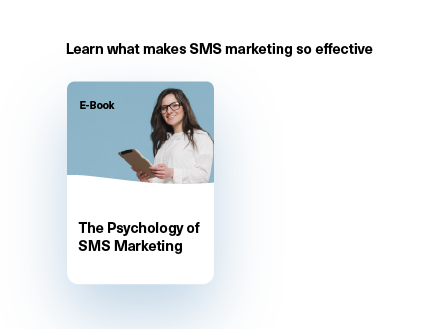SMS is the best tool to use when you need to reach customers or clients based overseas. The reasons are simple – SMS is affordable, reliable and delivered virtually instantly. It’s also the communication channel that offers the most impact; SMS has a 98% open rate – which means 9 out of 10 people open their text messages. Keep reading to learn how to send international SMS messages.
No matter where your customers or clients are in the world, an effective SMS service for messages will enable you to send important updates at the click of a button. These services are a game-changer for businesses and organizations with an international reach.
With the right solution in your corner, sending custom SMS messages across the globe is as easy as pinging an email to your entire customer base. It's never been easier to leverage SMS communication.
How sending an SMS worldwide works
Texts are sent and delivered internationally using mobile network carriers and SMS providers. An SMS provider acts as a gateway to mobile operators and different messaging routes around the world.
At Messente, we’ve formed connections with some 800 mobile networks and hubs in more than 190 countries worldwide – and we offer intelligent, adaptive routing algorithms to ensure text messages are delivered fast, no matter where you’re sending them to.
What you need to start sending international text messages
Anyone can send an international SMS using their mobile phone. However, if you want to use bulk text messaging for business, you’ll need to use an SMS provider and an SMS API. An SMS API is a type of software that allows web applications to send text messages.
Using an SMS provider means you don’t need to connect with hundreds of mobile networks individually to send your text messages. The SMS provider handles that for you. It also allows you to upload a database of contacts, create a Sender ID, and send a single text message to tens, hundreds, or even thousands of customers simultaneously.
You can integrate an SMS API into your CRM tool, which in itself provides many benefits. For instance, you can send personalised and proactive texts to customers, send automated notifications, and even allow texts to be turned into support tickets for fast resolution to issues.
If you need to quickly capture the attention of your customers or clients, SMS communication is the way to go. While email marketing is still remarkably effective, it fails to capture the same attention as a simple text message. SMS communication typically comes with an instant notification on the recipient's mobile device.
How to send SMS worldwide with Messente
If you are interested in exploring ways to send SMS messages across the globe, you should take Messente for a test drive. This is an all-encompassing platform designed to streamline your SMS campaigns and support your success.
Messente offers a couple of ways to get started with sending international SMS messages. The first is via our easy-to-use online dashboard. You simply register for an account (free), create a Sender ID, upload your list of subscribers and compose a text.
You can preview your campaign before you send it. Messente works out the cost depending on the destination countries you’re sending to and the volume of text messages. Learn more about SMS pricing.
The second (most effective) way to send SMS worldwide with Messente is to integrate our SMS API into your business systems. The integration gives you greater flexibility with SMS campaigns, better data insights, and, ultimately, better customer engagement.
We offer a wealth of technical documentation to help your developer integrate Messente; the process can be done in just half a day. If you’re familiar with basic coding, you may even be able to integrate Messente yourself. Use our Quickstart guide for our easy three-step process.
When might you need a global SMS strategy?
There are several use cases for sending international SMS messages, particularly for the travel industry, but also for retail and e-commerce, and any B2C or B2B organisation with a global customer base. Take a look at these examples:
Travel confirmations and cancellations
Airlines, travel agents and car hire companies are among those that could use SMS to deliver travel confirmations or cancellations. Texts can also be used for sending notifications that may affect travel, such as weather warnings, shipping forecasts and airport closures.
Travel insurance details
Customers booking travel insurance could be sent an SMS with their policy details and FAQs, plus details on how to make a claim. Most mobile phone owners keep their phones close by for most of the day, so having this information on hand would be helpful in case of an emergency.
Hotel booking confirmations
Hotel confirmations, cancellations, check-in and check-out times are just a few use cases for the hotel industry. SMS could also be used to enhance the customer’s stay – by sending details of local attractions to visit, links to maps for directions and links to menus and table reservation forms for hotel restaurants. Learn how to use links in SMS.
Promotional texts
Any business with customers around the globe can use SMS for a range of promotional campaigns. Examples include flash sale notifications, special offers, VIP customer discounts, product review requests, back-in-stock alerts and more.
Order confirmations
E-commerce businesses can use SMS to send order and payment confirmations, dispatch notifications and delivery updates. No matter where the customer is located, the text will be received virtually instantly, offering them peace of mind. Reliable confirmations can also stave off unnecessary enquiries, helping support agents focus on more complex tasks.
Transactional texts
SMS is frequently used across the financial industry to deliver PIN codes for two-factor authentication (2FA), which helps protect customers against fraud, account hacking and data breaches. Learn how to use Messente’s SMS API to verify your customer’s phone number.
Another excellent use of SMS is for payment reminders and debt collection texts. This is beneficial for the FinTech sector and any business needing to improve cash flow problems caused by late payments.
Reach customers faster with international SMS
Text messaging is the ideal way to send communications to overseas customers or clients. SMS doesn’t rely on wi-fi (just a cellular connection), so you can even deliver messages reliably to customers based in remote locations.
Many businesses can benefit from a global SMS strategy – it’s an ideal communication channel for the travel, hotel, FinTech, and e-commerce industries – to name just a few.
Getting started sending SMS worldwide is simple with Messente. Create your account today and send your first text message free – we’ll give you credits to try out our system.








